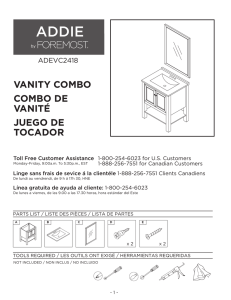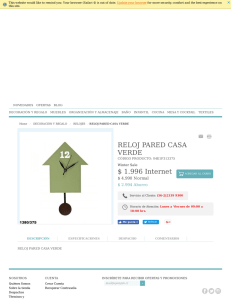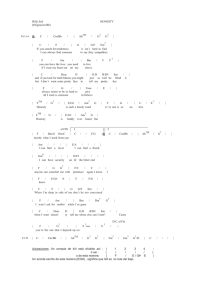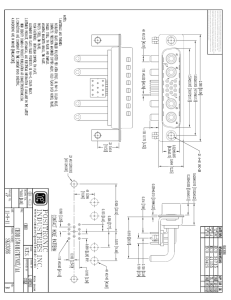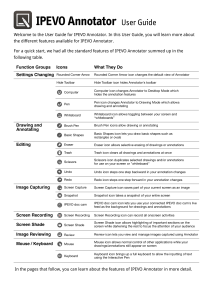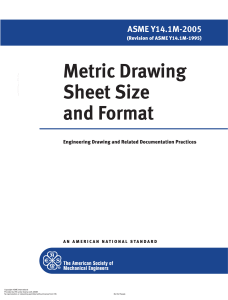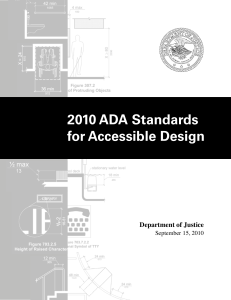Guide to Measuring Your Space
Anuncio
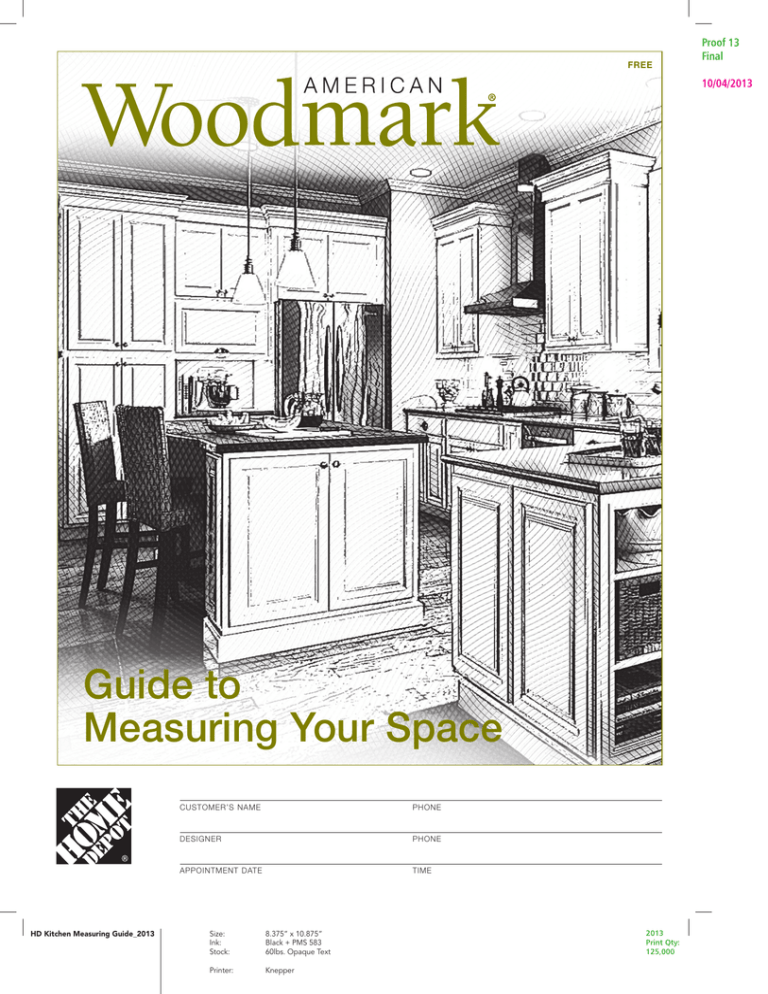
FREE Proof 13 Final 10/04/2013 Guide to Measuring Your Space CUSTOMER’S NAME PHONE DESIGNERPHONE APPOINTMENT DATE HD Kitchen Measuring Guide_2013 Size: Ink: Stock: 8.375” x 10.875” Black + PMS 583 60lbs. Opaque Text Printer:Knepper TIME 2013 Print Qty: 125,000 MEASURING YOUR SPACE Accurate measuring is a critical step in the remodeling process. Measurement errors are a source of significant delays and costly overruns. This guide walks you through the five easy steps to create drawings and provide the information necessary for your kitchen designer to start the design process: 1 Floor Plan Drawing . . . . . . . . page 4 A birds-eye view of your space Obtaining a professional measurement of your space is highly recommended — talk to your designer for more details. 2 Wall Elevation Drawing . . . . . . page 5 A vertical and horizontal map of each wall, from a straight-on view 3 Please read ALL of these instructions carefully from start to finish before beginning to measure your space. For more information, visit Construction Details . . . . . . . page 6 Important information for your renovation project 4 www.woodmarkcabinetry.com Appliances . . . . . . . . . . . . page 6 Dimensions and manufacturers' specs for your appliances Before your Kitchen Designer can begin to design your new space and help you select your cabinetry and appliances, they will need to know the size of your space and the important construction details. 5 Photography . . . . . . . . . . . . page 6 Photos of your space before renovation IMPORTANT NOTES ABOUT MEASURING FOR RENOVATIONS Measure in INCHES Cabinets and appliances are measured in inches, so your drawings should be r­ecorded in inches, not feet and inches. Example: 138-1⁄8 in. NOT 11 ft. 6-1⁄8 in. For walls and openings, ROUND DOWN When you measure ceilings, walls and openings, round down to the nearest 1/8 inch. Example: 138-1⁄8 in. NOT 138-3 ⁄16 in. Recording your measurements For appliances, ROUND UP We've provided graph paper to help with your final drawings. It is much more important to record accurate dimensions, rather than draw your room to a precise scale. Be sure to write the actual dimensions on your drawings for all the elements in your space. When you measure appliances round up to the nearest inch. Example: 36 in. NOT 35-11⁄16 in. 1 full inch 3/4 1/2 You do not need to measure closer than 1/8 inch. 1/4 1/8 Record this as 12 inches, NOT 1 foot Record this as 13 inches, NOT 1 foot, 1 inch USE ONLY METAL MEASURING TAPES Cloth or plastic tapes may stretch, causing measuring errors. Standard US construction materials are measured in inches. Use a US tape measure and record your dimensions in inches, not feet and inches. Do not use this side of the ruler, or metric measurements 2 | For more information, visit www.woodmarkcabinetry.com Proof 13 Final MEASURING TIPS A A Here are helpful tips on how to properly measure your space and record the correct window, door and utility information for your floor plan and wall elevation drawings. B Always double-check your measurements! Round down to the nearest 1/8 inch, and write it on your drawings. 23 1/8" 10/04/2013 B D E C Floor Measuring doors and windows Your designer needs to know the exact location of windows and doors, as well as the size of each opening (including the trim) in order to plan your new space. Record all of these measurements: A. Width, including trim B. Height, including trim C. Distance from floor Locate windows and doors Measure from the wall to the outside edge of the trim on all your doors and windows. D. From floor to top of window E. Width of the window sill Range hoods If you have an existing range hood vent or over the range wall microwave, note the location on your drawing. Specify if it exhausts back into the room, or if it has ducts that vent to outside. Locate outlets and switches Locate water and utility lines Measure horizontally to the center of the wall plate and vertically from the floor as shown. Mark the center line location of the sink, water lines, drains, gas lines and heating/air conditioning vents. 220 volt outlets Be sure to show any 220 volt outlets on your drawing. Do you have an electric stove? Then you'll have a 220 volt outlet for your stove. Your outlet may not look exactly like the example shown here, but it will look different from standard 110 volt outlets. IMPORTANT! Be sure to write the measurements on your drawings! Most grid paper is to scale, but your designer won't know what size your space is unless you write down the dimensions. 3 1 CREATING A FLOOR PLAN DRAWING A Floor Plan is a "bird's eye" view of the whole room, showing all four walls and the location of important utilities. Locate islands and peninsulas Start with your wall drawings The total of your wall segments must equal your overall wall length. Start your Floor Plan with Wall A, the sink wall. Then go clockwise around the room with walls B, C, and D. Mark the locations of openings and fixtures along the wall segments. Example: 62-1/2 in. + 36 in. + 39-3/4 in. = 138-1/4 in. Locate ceiling lights and other fixtures Measure in two directions to locate the center of ceiling lights, fans, air vents, and any other fixtures in the floor or ceiling. If there is an existing island or peninsula, mark its size and location. Mark any outlets or utilities coming to these structures. Always double-check your measurements! Transfer measurements to grid Transfer all of your measurements to the grid pages in this guide following the example below. It is more important to write down the exact measurements than to draw the floor plan to scale. 4 | For more information, visit www.woodmarkcabinetry.com Proof 13 Final 2 CREATING WALL ELEVATION DRAWINGS Elevation drawings are a straight-on view of each wall, with all the features measured vertically and horizontally, placing them on the wall space. This helps your designer locate your new cabinets and appliances along your walls. Measure to the outside edge of the trim. Then measure from the outside trim edge to the next opening, or to the far wall. Follow the measuring tips on page 2 to capture all the important details about windows and doors. Locate fixtures and utilities Start with the sink wall, go clockwise from there Measure horizontally to the center of outlets, switches, water lines and other utilities. Also measure the distance of these items from the floor. If there are HVAC wall vents, mark their location and size. Follow the measuring tips on page 3 for accuracy. Start measuring your room with the sink wall. Label this Wall A. Then go clockwise around your room, labeling the walls B, C, and D. Transfer measurements to grid Draw a rough sketch Transfer all of your measurements to the grid pages in this guide. Label your drawings Wall A, Wall B, Wall C and Wall D. Then begin the Floor Plan Drawing. Start by drawing a rough sketch (or two!) of each wall on a separate sheet of paper. Measure the width of the wall Measure the full width of each wall, beginning in the left corner. Check the width at two locations, 6 inches above the finished floor and 6 inches below the ceiling. Use the smallest dimension. 10/04/2013 Locate the openings If your space is L-shaped or has a bump out area, you can still draw an elevation view straight on. Just use a vertical line to show where the wall comes forward. Measure the height of the wall Measure the full height of each wall, beginning in the left corner. Check the height at two other locations. Use the smallest dimension. If your floor plan looks like this drawing … … your elevation view will look like this drawing. Always double-check your measurements! The total of your wall segments should equal your overall length. 5 3 CONSTRUCTION DETAILS Entrances and access Soffits To make sure your new products fit through doorways into your space, record the actual openings for doors and hallways. A soffit, also called a bulkhead, is a wall section that is built out at the ceiling level, usually in the area above Soffit / Bulkhead wall cabinets. Entry Door: inches Does the room have soffits? Interior Door 1: inches Interior Door 2: inches ❑ Yes Wall cabinets are often hung below a soffit. ❑ No If yes, please fill out the two dimensions in the diagram to the right. Do you plan to keep the existing soffits? ❑ Yes ❑ No Hallway:inches Is there a basement or crawl space under the room that provides access to plumbing and heating ducts? ❑ Yes Ceiling Will the soffits have recessed lighting after the renovation? ❑ Yes ❑ No ❑ No WARNING: Soffits typically contain electrical and plumbing elements that can’t be relocated. Consult a professional on your remodel. 4 APPLIANCES Appliance dimensions are critical to the overall fit of all kitchen components. Whether you are buying new appliances or using existing ones, provide the dimensions for each appliance in your kitchen. Door hinges and handles can obstruct surrounding c­ abinets and must be Existing New None factored into the design. Whenever possible, provide brand, model and spec sheets for appliances. Spec sheets are installation guides that list the dimensions of the appliance. Please provide all appliance information. Brand Model Dimensions W x D x H Spec Sheets Enclosed? Sink n n n ✕ ✕ n Yes n No Disposal n n n ✕ ✕ n Yes n No n ✕ ✕ n Yes n No Dishwasher n n Compactor n n n ✕ ✕ n Yes n No Refrigerator n n n ✕ ✕ n Yes n No Freezer, stand alone n n n ✕ ✕ n Yes n No Range n n n ✕ ✕ n Yes n No n ✕ ✕ n Yes n No Cook Top n n Exhaust Hood n n n ✕ ✕ n Yes n No Wall Oven n n n ✕ ✕ n Yes n No Microwave, wall mount n n n ✕ ✕ n Yes n No Microwave, countertop n n n ✕ ✕ n Yes n No n Yes n No n Yes n No Other: n n n ✕ ✕ Other: n n n ✕ ✕ 5 PHOTOGRAPHY Take photos of your space and share them with your Kitchen Designer. Label your shots to match your walls: A, B, C, D 6 | For more information, visit www.woodmarkcabinetry.com ❑ Straight on views of each wall: A (the sink wall), B, C, D (go clockwise around the room.) ❑ Photos of soffits or other construction details ❑ Close ups of anything unusual in your space: air vents, plumbing or gas lines, entrances or access notes. Scale: 3/4˝ = 1´ FLOOR PLAN See instructions on page 4. 159 1/2” ❑ Window & Door Openings Door swing ❑ Longitudes de pared ❑ Wall Light Locations Show if the door opens in or out of the room, swings to the left or the right side. ❑ Aberturas de ventanas y puertas ❑ Water Lines Note: ❑ Thermostat ❑ Drain Lines ❑ Switches, Phone and TV ❑ 110 Volt Electrical Outlets S 110 ❑ Gas Line ❑ Range Hood ❑ 220 Volt Electrical Outlets 220 Asegúrese de incluir estos elementos en el dibujo usando estos símbolos: ❑ Ceiling Light Locations ❑ Ceiling Fan Locations ❑ Heating Ventilation and Air Conditioning (HVAC) Vents PLANO Ver instrucciones en la página 9. Be sure to include these items on your drawing, using these symbols: ❑ Wall Lengths Escala: 3/4˝ = 1´ Keep in mind that each large square equals one foot and each small square equals 3 inches. The scale of this grid is 3/4” = 1’. Ph IMPORTANT: Some cabinets or appliances may not fit through an existing doorway. Make sure you measure the width of all doorway openings on this floor plan drawing. For more information, visit www.woodmarkcabinetry.com 159 1/2” ❑U bicaciones de luces de techo ❑U bicaciones de luces de pared Abertura de la puerta Muestre si la puerta se abre hacia adentro o hacia fuera de la habitación, con un movimiento hacia la derecha o la izquierda. ❑U bicaciones de ventiladores de techo ❑Caños de agua Nota: ❑Caños de drenaje ❑ Termostato ❑ S alidas de calefacción, ventilación y aire acondicionado (HVAC) ❑ Interruptores, teléfono y TV S Ph ❑ Tomacorrientes de 110 voltios 110 ❑Caño de gas ❑ Tomacorrientes de 220 voltios 220 ❑Campana de estufa Recuerde que cada cuadrado grande equivale a un pie y cada cuadrado pequeño equivale a 3 pulgadas. La escala de esta cuadrícula es 3/4” = 1’. IMPORTANTE: Algunos armarios o electrodomésticos podrían no caber por las puertas existentes. Asegúrese de medir el ancho de todas las aberturas de las puertas en este dibujo del plano. Para obtener más información, visite www.woodmarkcabinetry.com Width and height for doors & windows, including the frames (see tips on page 3) Wall lengths and heights, and wall segment lengths (the space between items) 110 Volt Electrical Outlets 220 Volt Electrical Outlets Gas Lines G Switches, Phone, TV 220 110 S Ph TV Be sure to include these items on your drawing: Water Lines & Drains 159 1/2" A C 110 How to indicate location of electrical outlets and switches. 16˝ 110 42˝ Indicates 42˝ from floor Indicates 16˝ from wall to center of outlet. (Measured from the left side, reverse if measuring from the right) Indicates 110 V outlet Scale: 1/2˝ = 1´ | Escala: 1/2˝ = 1´ Scale: 1/2˝ = 1´ | Escala: 1/2˝ = 1´ Indica 16" desde la pared hasta el centro del tomacorriente. (Medida desde el lado izquierdo; revertir si mide desde la derecha) Cómo indicar la ubicación de tomas de corriente e interruptores. ELEVATIONS: SINK WALL, WALL A | ELEVACIONES: PARED DE FREGADERO, PARED A G ELEVATIONS: WALL C | ELEVACIONES: PARED C Asegúrese de incluir estos elementos en el dibujo: Caños de gas 220 Tape measure (25' to ensure accuracy) Pencil with eraser Scrap paper Ruler or straight edge Step ladder Digital camera Recommended: ELEVATIONS: WALL D | ELEVACIONES: PARED D ELEVATIONS: WALL B | ELEVACIONES: PARED B Before you begin measuring your space, make sure you have all the tools you need on hand. Assistant D B Digital measuring tool IMPORTANT! Be sure to write the measurements on your drawings! Most grid paper is to scale, but your designer won't know what size your space is unless you write down the dimensions. For more information, visit www.woodmarkcabinetry.com Scale: 1/2˝ = 1´ | Escala: 1/2˝ = 1´ Scale: 1/2˝ = 1´ | Escala: 1/2˝ = 1´ Open and remove folded insert to create Floor Plan and Wall Elevation drawings. Translations: Complete 159 1/2" Tomacorrientes de 220 voltios 16˝ 110 Materials List: English: Approved Longitudes y alturas de paredes y longitudes de segmentos de paredes (espacio entre artículos) Tomacorrientes de 110 voltios S Ph TV Indica 42" desde el suelo See instructions on page 5. 16.50”w x 21.50”h Ancho y altura para puertas y paredes, incluidos los marcos (ver consejos en la página 10) Interruptores, teléfono, TV 42˝ Grid Insert WALL ELEVATION DRAWING 10/04/2013 Caños de agua y desagües Indica tomacorrientes de 110 V 2013 Print Qty: 125,000 Trim Size: 16.5” x 21.5” Folded Size: 8.25” x 10.75 Ink: Black + PMS 583 Stock: 60lbs. Opaque Text Binding: Folder and placed as center spread Printer:Knepper HD Kitchen Measuring Guide_2013 _Grid Insert Proof 13 Final Para obtener más información, visite www.woodmarkcabinetry.com Abra y retire el anexo doblado para dibujar el plano y las elevaciones de pared. En general, el papel cuadriculado es a escala, pero su diseñador no sabrá el tamaño de su espacio a menos que anote las dimensiones. ¡Asegúrese de escribir las medidas en sus dibujos! ¡IMPORTANTE! Herramienta de medición digital Asistente Se recomienda: Cámara digital Escalera Regla o borde recto Papel para anotaciones Lápiz con goma de borrar Cinta métrica (de 25' para garantizar la precisión) Antes de comenzar a medir su espacio, asegúrese de tener todas las herramientas necesarias a mano. Lista de materiales: Ver instrucciones en la página 8 DIBUJO DE LA ELEVACIÓN DE LA PARED
